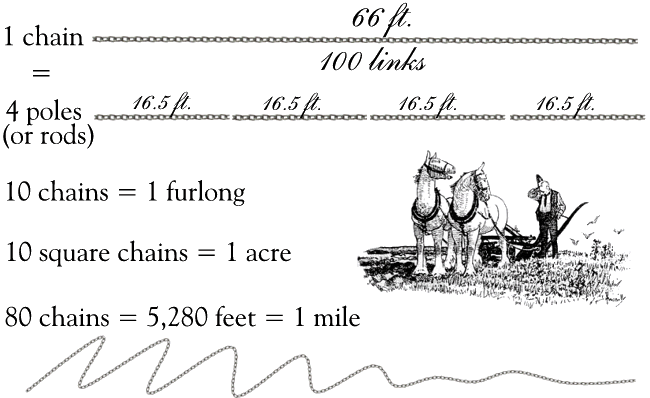What the Heck is a "Chain"?
 he "chain" is a unit of measurement that
was invented in the early 1600's by an English mathematician
named Edmund Gunter. One chain equals 66 feet. This
number may seem odd, but Gunter chose it because it was equal to
one-tenth of a furlong, which was a common measurement
used by English farmers and landowners. The furlong (220
yards or 660 feet) was the standard length of a furrow in a
ploughed field ("furrow long" = furlong). It was
supposedly the distance that a horse could pull a plough before
needing to rest. An acre is one square
furlong. The furlong and acre were so important in
agriculture that the English government redefined the ancient
Roman mile, which contained 5,000 feet,* to 8 furlongs, or 5,280
feet. One square mile is 640 acres.
he "chain" is a unit of measurement that
was invented in the early 1600's by an English mathematician
named Edmund Gunter. One chain equals 66 feet. This
number may seem odd, but Gunter chose it because it was equal to
one-tenth of a furlong, which was a common measurement
used by English farmers and landowners. The furlong (220
yards or 660 feet) was the standard length of a furrow in a
ploughed field ("furrow long" = furlong). It was
supposedly the distance that a horse could pull a plough before
needing to rest. An acre is one square
furlong. The furlong and acre were so important in
agriculture that the English government redefined the ancient
Roman mile, which contained 5,000 feet,* to 8 furlongs, or 5,280
feet. One square mile is 640 acres.
If you look at old measuring systems, they are usually based on units of 2 or 3, or multiples of 2 or 3, like 4, 8, and 12. This makes a lot of sense. People really do not think in decimals -- if you don't believe me, try cutting a pie into 10 equal pieces! Systems of measurement based on 2 and 3 have great advantages over decimals in everyday life because they are intuitive. They do not depend on standardized measuring devices, literacy, or even any knowledge of arithmetic. All you have to do is divide things into halves and thirds. There are good reasons why baked goods are traditionally sold by the dozen, why we have 12 hours in a day (not 10) and 4 quarts in a gallon (not 5).
Decimals, however, are clearly superior for mathematical calculations. Gunter, a mathematician, certaintly realized this, which is why he created a decimal system to improve the science of surveying (100 "links" = 1 chain = 1/10 furlong).
Although Gunter's chain has gone the way of the horse-drawn plough, we Americans have obstinantly stuck to our oddball acres and miles, thumbing our noses at the entire metric world. So in very real sense, the chain is still with us.
To convert measurements of all sorts, visit Online
Conversion.com![]()
________________________________
*To be completely accurate, the Roman mile contained 5,000 Roman feet, which were a bit shorter than English feet -- about 11.5 inches as we measure them. The Romans defined the mile as the distance covered by an army marching 1,000 paces. The word "mile" comes from the Latin milia passum, meaning 1,000 paces.
